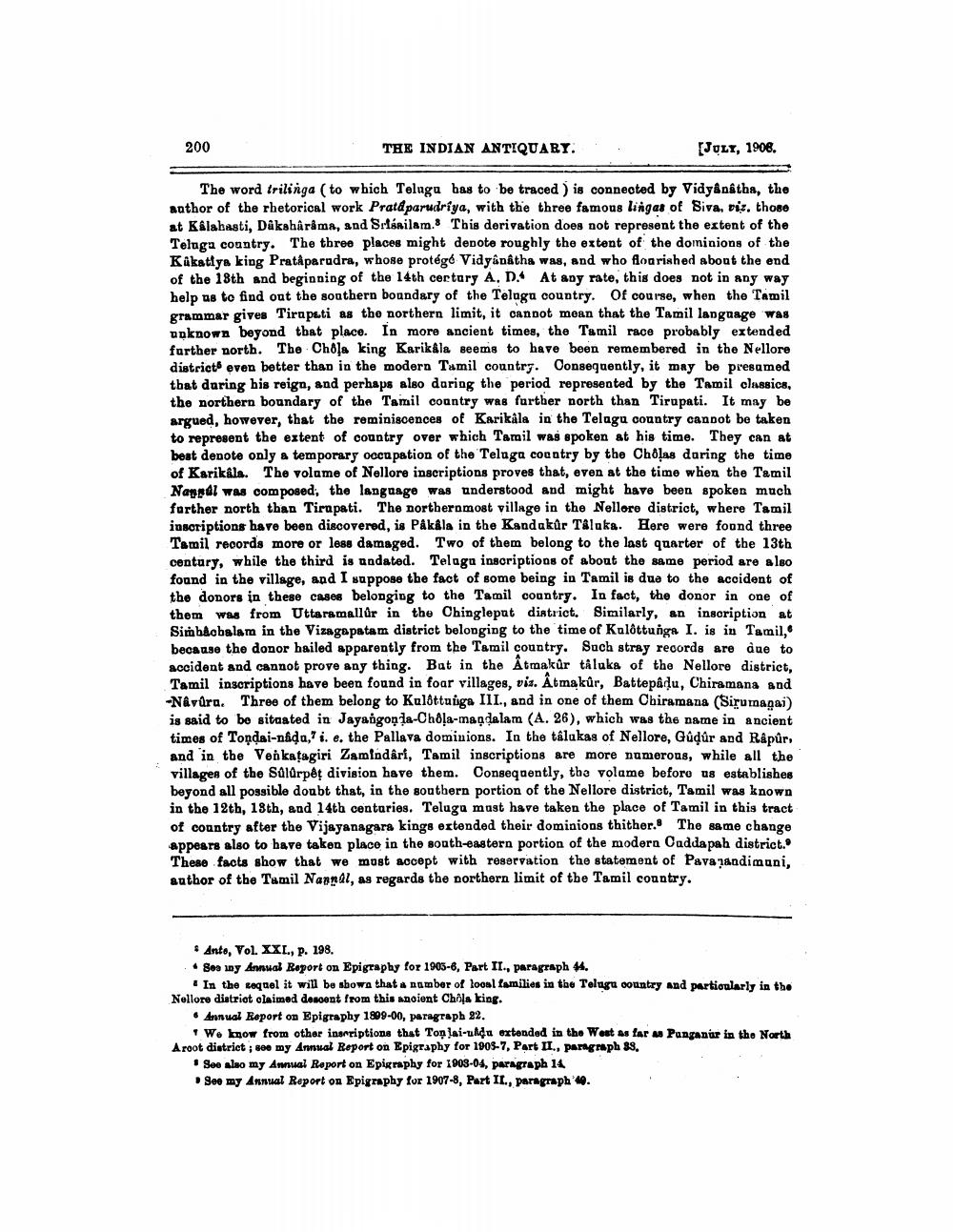________________
200
THE INDIAN ANTIQUARI...
(JULY, 1908.
The word trilinga (to which Telaga has to be traced ) is connected by Vidyânâtha, the author of the rhetorical work Pratdparudriya, with the three famous lingas of Siva, viz. those at Kalahasti, Dakshâråma, and Srisailam. This derivation does not represent the extent of the Telaga country. The three places might depote roughly the extent of the dominions of the Kakatiya king Pratâparadra, whose protégé Vidyanatha was, and who floarished about the end of the 18th and beginning of the 14th certory A. D. At any rate, this does not in any way help us to find out the southern boundary of the Teluga country. Of course, when the Tamil grammar gives Tirapati as the northern limit, it cannot moan that the Tamil language was unknown beyond that place. In more ancient times, the Tamil race probably extended farther north. The Chola king Karikála seems to have been remembered in the Nellore districts even better than in the modern Tamil country. Consequently, it may be presumed that during his reign, and perhaps also during the period represented by the Tamil classics, the northern boundary of the Tamil country was further north than Tirupati. It may be argued, however, that the reminiscences of Karikala in the Telugu country cannot be taken to represent the extent of country over which Tamil was spoken at his time. They can at beat denote only a temporary occupation of the Teluga cocotry by the Chôļas daring the time of Karikála. The volame of Nellore inscriptions proves that, even at the time when the Tamil Nampal was composed, the language was understood and might have been spoken much further north than Tirupati. The northernmost village in the Nellore district, where Tamil inscriptions have been discovered, is Påkala in the Kandakür Talaka. Here were found three Tamil records more or less damaged. Two of them belong to the last quarter of the 13th century, while the third is andated. Telaga inscriptions of about the same period are also found in the village, and I happose the fact of some being in Tamil is due to the accident of the donors in these cases belonging to the Tamil country. In fact, the donor in one of them was from Uttaramallur in the Chinglepat district. Similarly, an inscription at Simbachalam in the Vizagapatam district belonging to the time of Kulottunga I. is in Tamil, because the donor hailed apparently from the Tamil country. Such stray records are due to accident and cannot prove any thing. But in the Atmakûr taluks of the Nellore district.
Tamil inscriptions have been found in foar villages, vis. Ätmakûr, Battepadu, Chiramana and --Navûra. Three of them belong to Kulttuiiga III., and in one of them Chiramana (Sirumagai) is said to be sitaated in Jayangonla-Cha-magdalam (A. 26), which was the name in ancient times of Tondai-nada," i.e. the Pallava dominions. In the tâlukas of Nellore, Gudúr and Rapûr, and in the Venkatagiri Zamindâri, Tamil inscriptions are more numerous, while all the villages of the Súlurpêt division have them. Consequently, the volame before us establishes beyond all possible doubt that, in the southern portion of the Nellore district, Tamil was known in the 12th, 13th, and 14th centuries. Telugu must have taken the place of Tamil in this tract of country after the Vijayanagara kings extended their dominions thither. The same change appears also to have taken place in the south-eastern portion of the modera Caddapah district. These facts show that we must accept with reservation the statement of Pavalandimuni, author of the Tamil Nannal, as regards the northern limit of the Tamil country.
. Anto, Vol. XXI., P. 198. .. Sea by Annual Report on Epigraphy for 1905-8, Part II., paragraph 44.
* In the sequel it will be shown that a number of looal families in the Telugu country and partioularly in the Nellore distriot claimed descent from this ancient Chola king.
. Annual Report on Epigraphy 1899-00, paragraph 22.
W. know from other inscriptions that Toņlai-ulça extended in the West as far as Panganur in the North A root district: soomy Anual Report on Epigraphy for 1909-7, Part II., paragraph 88.
• See also my Annual Report on Epigraphy for 1903-04, paragraph 14
See my Annual Report on Epigraphy for 1907-8, Part II., paragraph .




